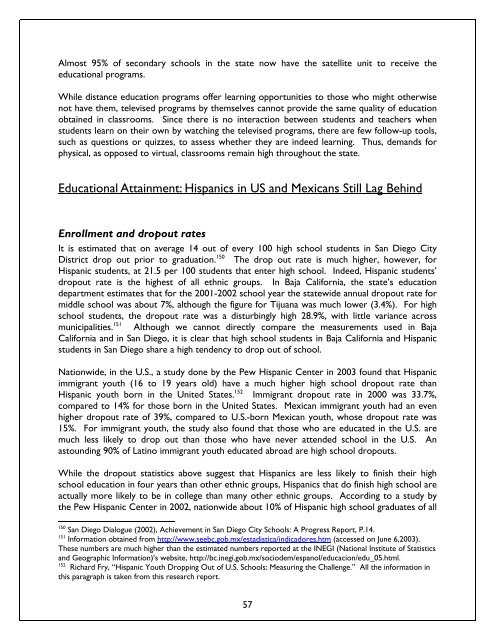Blurred Borders - International Community Foundation
Blurred Borders - International Community Foundation
Blurred Borders - International Community Foundation
Create successful ePaper yourself
Turn your PDF publications into a flip-book with our unique Google optimized e-Paper software.
Almost 95% of secondary schools in the state now have the satellite unit to receive the<br />
educational programs.<br />
While distance education programs offer learning opportunities to those who might otherwise<br />
not have them, televised programs by themselves cannot provide the same quality of education<br />
obtained in classrooms. Since there is no interaction between students and teachers when<br />
students learn on their own by watching the televised programs, there are few follow-up tools,<br />
such as questions or quizzes, to assess whether they are indeed learning. Thus, demands for<br />
physical, as opposed to virtual, classrooms remain high throughout the state.<br />
Educational Attainment: Hispanics in US and Mexicans Still Lag Behind<br />
Enrollment and dropout rates<br />
It is estimated that on average 14 out of every 100 high school students in San Diego City<br />
District drop out prior to graduation. 150 The drop out rate is much higher, however, for<br />
Hispanic students, at 21.5 per 100 students that enter high school. Indeed, Hispanic students’<br />
dropout rate is the highest of all ethnic groups. In Baja California, the state’s education<br />
department estimates that for the 2001-2002 school year the statewide annual dropout rate for<br />
middle school was about 7%, although the figure for Tijuana was much lower (3.4%). For high<br />
school students, the dropout rate was a disturbingly high 28.9%, with little variance across<br />
municipalities. 151 Although we cannot directly compare the measurements used in Baja<br />
California and in San Diego, it is clear that high school students in Baja California and Hispanic<br />
students in San Diego share a high tendency to drop out of school.<br />
Nationwide, in the U.S., a study done by the Pew Hispanic Center in 2003 found that Hispanic<br />
immigrant youth (16 to 19 years old) have a much higher high school dropout rate than<br />
Hispanic youth born in the United States. 152 Immigrant dropout rate in 2000 was 33.7%,<br />
compared to 14% for those born in the United States. Mexican immigrant youth had an even<br />
higher dropout rate of 39%, compared to U.S.-born Mexican youth, whose dropout rate was<br />
15%. For immigrant youth, the study also found that those who are educated in the U.S. are<br />
much less likely to drop out than those who have never attended school in the U.S. An<br />
astounding 90% of Latino immigrant youth educated abroad are high school dropouts.<br />
While the dropout statistics above suggest that Hispanics are less likely to finish their high<br />
school education in four years than other ethnic groups, Hispanics that do finish high school are<br />
actually more likely to be in college than many other ethnic groups. According to a study by<br />
the Pew Hispanic Center in 2002, nationwide about 10% of Hispanic high school graduates of all<br />
150 San Diego Dialogue (2002), Achievement in San Diego City Schools: A Progress Report, P.14.<br />
151 Information obtained from http://www.seebc.gob.mx/estadistica/indicadores.htm (accessed on June 6,2003).<br />
These numbers are much higher than the estimated numbers reported at the INEGI (National Institute of Statistics<br />
and Geographic Information)’s website, http://bc.inegi.gob.mx/sociodem/espanol/educacion/edu_05.html.<br />
152 Richard Fry, “Hispanic Youth Dropping Out of U.S. Schools: Measuring the Challenge.” All the information in<br />
this paragraph is taken from this research report.<br />
57















